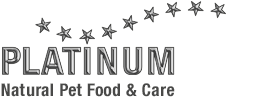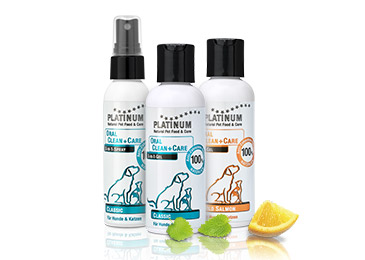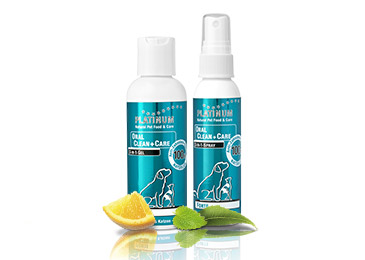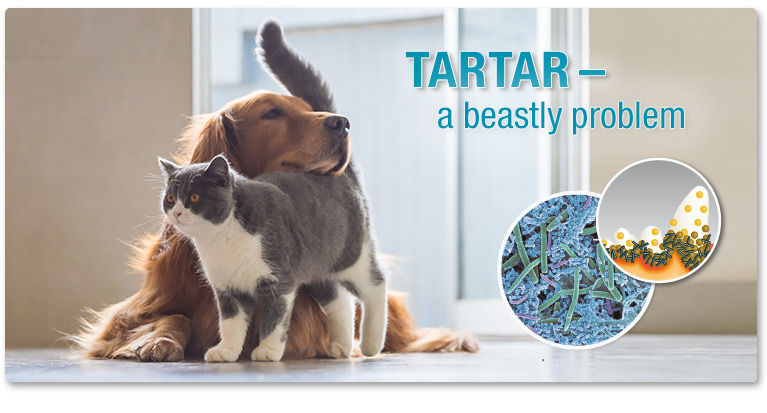
Tartar in dogs and cats...
...a beastly problem
The build-up of tartar is a gradual process that affects almost all dogs and cats at some point in their lives. It results in painful gum inflammations and periodontitis, and in the worst case tooth loss and bone resporption.
Tartar is the term used to describe hard yellow to brownish deposits on the teeth that cannot be removed either by rinsing or brushing. Tartar is formed by mineral salts from saliva mixing with plaque.

Plaque is a soft accumulation of deposits consisting of saliva, the remnants of food, bacteria and their metabolic products (1). Eventually, the mineral salts in saliva cause these deposits to harden (2) (3). Tartar itself does not lead to infection, but the bacteria which stick to its rough surface do (4). The products of their metabolic processes, which include acids, attack the teeth and the gums. In cats and dogs, the area around the excretory ducts of the salivary glands is particularly susceptible to tartar – this is the inside of the incisors in the lower jaw and the outside in the upper jaw.
The amount of tartar that forms depends on various factors such as the amount of saliva produced, the size of the spaces between the teeth and the composition of the bacterial microflora in the mouth. Particular attention should be paid to good dental care in animals with a hereditary tendency for dental problems.
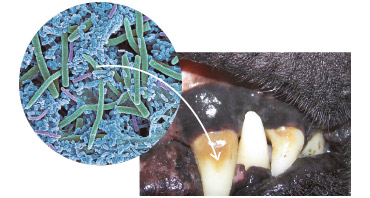
The image shows a tooth affected by tartar magnified 6000 times under an electron microscope. The tartar, which is porous (stained blue), offers the perfect structure for bacteria (stained green and purple) to colonise..
No plaque, no tartar!
One consequence of tartar is periodontitis, a bacterial infection which can cause irreparable damage in the oral cavity. Left untreated, the only option is the mechanical removal of the tartar by the vet, which usually takes place under general anaesthetic. In the worst case, the vet must extract the entire tooth. For older animals and those with pre-existing medical conditions, however, a general anaesthetic can often be a risky procedure.
Before the condition reaches this stage, you should try OralClean+Care for dogs and cats.
Thanks to OralClean+Care ...
... you can spare your pet the anaesthetic involved in tartar removal. All anaesthetics put considerable strain on the body.
Removing tartar effectively
In natural medicine, citrus seed extract is used for its anti-bacterial properties. In OralClean+Care, a combination of this natural ingredient and herbal essential oils cleanses the teeth by gradually dissolving the film of bacteria and gently removing plaque. The high quality ingredients penetrate deep into the gum pockets, fighting inflammation and relieving pain if the gums are infected.
All the ingredients in OralClean+Care are 100 percent natural and meet food safety requirements.
Only the best – naturally
No damage is done to the sensitive enamel of the teeth as this method of tartar removal does not involve acids. The citrus seed extract in OralClean+Care is from the seeds, not the flesh of the fruit, and is thus not acidic. Moreover, the alcohol content per application is so low that you need have no concerns about giving it to your pet. Your pet will swallow a little amount of OralClean+Care with every application, but this is completely normal and does not pose a health risk of any kind.
Gum inflammation in dogs and cats
Tartar can cause gum infections which are extremely painful and may lead to your pet being unable to eat.
